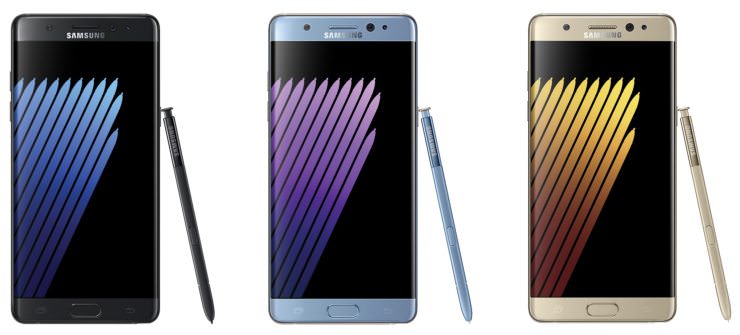Today, Samsung unveiled the Galaxy Note7, its latest extra-large-format, stylus-toting smartphone. The device features several new hardware and software features as well as a new design. However, the headline has to be that Samsung appears to be converging its two high-end product lines – the Galaxy S series and the Note series – in a way that sets things up in an interesting way for this fall, when we might well see Apple expand its iPhone product line too.
Sevens all around
Symbolically, the choice to skip the Note 6 and move straight to the Note 7 seems fitting, given Samsung appears to want to align its high-end devices more closely. The Note and Galaxy S lines have hitherto been pretty separate, sharing the occasional feature here and there, but largely positioned quite differently and with different specs and designs. This year, that changes, with the three phones being based on many of the same internals and sharing certain design cues as well. Thus, the differences narrow to stylus support, size, and specific features which are included in the new device, while many of the other details are the same.
One interesting question that arises from all this is whether this means we’ll eventually see the Note series launched earlier in the year, alongside the new Galaxy S devices. That seems unlikely, given it provides a useful boost for Samsung’s sales in the second half of the year and allows Samsung to respond to last-minute iPhone rumors. But if these devices are increasingly seen as members of the same line, it would make sense to launch them simultaneously.
A premium lineup in a declining market
This is undoubtedly a premium lineup – in the US, each of these devices is sold at over $650 unsubsidized and the Note7 will start in the high $800s. That’s interesting in a market in which the high-end is peaking due to longer upgrade cycles and slower growth in new smartphone customers. Both Apple and Samsung have suffered from this saturation and slowing of the market, but Samsung is clearly doubling down on this end of its portfolio. Samsung, of course, also has a massive mid-market portfolio too, but its market share at the high end is far higher. It makes sense to continue to invest there, especially given the higher margins available in the premium segment. Samsung had a great Q2, largely off the back of a much healthier upgrade cycle for the S7 phones and needs to continue to do well in this segment to feed its recent recovery.
Positioning against Apple
As I mentioned, the launch date of the Note series has often allowed Samsung to position this device more directly against new iPhones, which typically launch in late September. This year, that meant a not-so-subtle dig at the reported lack of a 3.5mm headphone jack in those iPhones with a reminder the Note7 definitely still has one, as well as a more subtle reference to a 64GB starting storage capacity. But there was also an indirect reference to Apple’s Pencil and the fact it’s sold separately and requires regular charging, while the Note7 comes with the non-chargeable stylus in the box. In reality, of course, this is a matter of bundling and positioning – the stylus is a key differentiator for the Note series and always has been, while it’s positioned as an optional extra for the iPad Pro. I almost never use mine, for example, while others may so, while Apple’s approach gives users the choice, it lays the company open to charges of nickel-and-diming customers, while Samsung bundles it in with a more expensive smartphone.
Samsung also announced an iris scanner on the Note7, which can be used not just for unlocking the phone but also for other security features including a secure folder of data on the device as well as signing in to online services and apps. Having played catch-up with Apple on fingerprint scanners, Samsung is now looking to move ahead with other biometric security options and the iris scanner is a useful next step. We’re going to see more and more of this one-up-manship between Samsung, Apple, and others as competition over a dwindling premium market intensifies and the big picture hardware features come closer to parity across devices.
An interesting setup for the fall
All this is particularly interesting precisely because we’re only a little over a month away from Apple’s presumed unveiling of its new lineup of iPhones, which is rumored to include a possible third option in the form of a “Pro” addition. Given it’s only been two years since Apple bifurcated its portfolio and just a few months since the junior member of the family – the iPhone SE – was added, this is a rapid diversification on Apple’s part if it turns out to be true. But this is also classic mature market strategy, in which a larger set of products is deployed to meet consumers’ needs more precisely in a saturated market. This increased specialization will likely continue and it will be interesting to compare Samsung and Apple’s approach of several models with Motorola and LG’s more modular approach. I suspect the former will do better, while the modular approach quickly fizzles. We’ll see.

Wonderful post! We will be linking to this great article on our site. Keep up the great writing
Great website. Lots of useful information here. I look forward to the continuation.